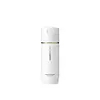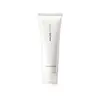What's inside
What's inside
 Key Ingredients
Key Ingredients

 Benefits
Benefits

 Concerns
Concerns

 Ingredients Side-by-side
Ingredients Side-by-side

Mannitol
HumectantSodium Cocoyl Glycinate
CleansingSodium Lauroyl Glutamate
Zeolite
AbsorbentSilica
AbrasiveBetaine
HumectantAllantoin
Skin ConditioningPotassium Laurate
EmulsifyingPolycaprolactone
StabilisingParfum
MaskingZea Mays Starch
AbsorbentPEG-75
HumectantDipotassium Glycyrrhizate
HumectantDisodium EDTA
Trehalose
HumectantWater
Skin ConditioningButylene Glycol
HumectantPapain
Skin ConditioningLactobacillus Ferment Lysate
Skin ConditioningCI 19140
Cosmetic ColorantZingiber Officinale Root Extract
MaskingZiziphus Jujuba Fruit Extract
Skin ConditioningCamellia Sinensis Leaf Extract
AntimicrobialMannitol, Sodium Cocoyl Glycinate, Sodium Lauroyl Glutamate, Zeolite, Silica, Betaine, Allantoin, Potassium Laurate, Polycaprolactone, Parfum, Zea Mays Starch, PEG-75, Dipotassium Glycyrrhizate, Disodium EDTA, Trehalose, Water, Butylene Glycol, Papain, Lactobacillus Ferment Lysate, CI 19140, Zingiber Officinale Root Extract, Ziziphus Jujuba Fruit Extract, Camellia Sinensis Leaf Extract
Water
Skin ConditioningGlycerin
HumectantStearic Acid
CleansingMyristic Acid
CleansingPotassium Hydroxide
BufferingLauric Acid
CleansingPEG-8
HumectantSodium Myristoyl Glutamate
CleansingGlyceryl Stearate
EmollientPEG-32
HumectantPEG/PPG-25/30 Copolymer
SolventSorbitol
HumectantPEG-200 Hydrogenated Glyceryl Palmate
CleansingCocamidopropyl Betaine
CleansingPhyllostachys Bambusoides Juice
Skin ConditioningPanax Ginseng Root Extract
EmollientMangifera Indica Seed Butter
Skin ConditioningOlea Europaea Fruit Oil
MaskingHelianthus Annuus Seed Oil
EmollientAlgae Extract
EmollientGlycyrrhiza Glabra Root Extract
BleachingCorallina Officinalis Extract
Skin ConditioningLactose
HumectantDisodium EDTA
Microcrystalline Cellulose
AbsorbentButylene Glycol
HumectantSucrose
HumectantAlcohol
AntimicrobialZea Mays Starch
AbsorbentOlive Oil PEG-8 Esters
EmollientCI 77007
Cosmetic ColorantXanthan Gum
EmulsifyingTocopheryl Acetate
AntioxidantTrehalose
HumectantTriclosan
PreservativePhosphatidylcholine
EmulsifyingPropylene Glycol
HumectantPEG-100 Stearate
PEG-14m
Emulsion StabilisingPEG-5 Rapeseed Sterol
CleansingPEG-7 Glyceryl Cocoate
EmulsifyingHydrogenated Lecithin
EmulsifyingSodium Benzoate
MaskingParfum
MaskingWater, Glycerin, Stearic Acid, Myristic Acid, Potassium Hydroxide, Lauric Acid, PEG-8, Sodium Myristoyl Glutamate, Glyceryl Stearate, PEG-32, PEG/PPG-25/30 Copolymer, Sorbitol, PEG-200 Hydrogenated Glyceryl Palmate, Cocamidopropyl Betaine, Phyllostachys Bambusoides Juice, Panax Ginseng Root Extract, Mangifera Indica Seed Butter, Olea Europaea Fruit Oil, Helianthus Annuus Seed Oil, Algae Extract, Glycyrrhiza Glabra Root Extract, Corallina Officinalis Extract, Lactose, Disodium EDTA, Microcrystalline Cellulose, Butylene Glycol, Sucrose, Alcohol, Zea Mays Starch, Olive Oil PEG-8 Esters, CI 77007, Xanthan Gum, Tocopheryl Acetate, Trehalose, Triclosan, Phosphatidylcholine, Propylene Glycol, PEG-100 Stearate, PEG-14m, PEG-5 Rapeseed Sterol, PEG-7 Glyceryl Cocoate, Hydrogenated Lecithin, Sodium Benzoate, Parfum
 Reviews
Reviews

Ingredients Explained
These ingredients are found in both products.
Ingredients higher up in an ingredient list are typically present in a larger amount.
Butylene Glycol (or BG) is used within cosmetic products for a few different reasons:
Overall, Butylene Glycol is a safe and well-rounded ingredient that works well with other ingredients.
Though this ingredient works well with most skin types, some people with sensitive skin may experience a reaction such as allergic rashes, closed comedones, or itchiness.
Learn more about Butylene GlycolDisodium EDTA plays a role in making products more stable by aiding other preservatives.
It is a chelating agent, meaning it neutralizes metal ions that may be found in a product.
Disodium EDTA is a salt of edetic acid and is found to be safe in cosmetic ingredients.
Learn more about Disodium EDTAParfum is a catch-all term for an ingredient or more that is used to give a scent to products.
Also called "fragrance", this ingredient can be a blend of hundreds of chemicals or plant oils. This means every product with "fragrance" or "parfum" in the ingredients list is a different mixture.
For instance, Habanolide is a proprietary trade name for a specific aroma chemical. When used as a fragrance ingredient in cosmetics, most aroma chemicals fall under the broad labeling category of “FRAGRANCE” or “PARFUM” according to EU and US regulations.
The term 'parfum' or 'fragrance' is not regulated in many countries. In many cases, it is up to the brand to define this term.
For instance, many brands choose to label themselves as "fragrance-free" because they are not using synthetic fragrances. However, their products may still contain ingredients such as essential oils that are considered a fragrance by INCI standards.
One example is Calendula flower extract. Calendula is an essential oil that still imparts a scent or 'fragrance'.
Depending on the blend, the ingredients in the mixture can cause allergies and sensitivities on the skin. Some ingredients that are known EU allergens include linalool and citronellol.
Parfum can also be used to mask or cover an unpleasant scent.
The bottom line is: not all fragrances/parfum/ingredients are created equally. If you are worried about fragrances, we recommend taking a closer look at an ingredient. And of course, we always recommend speaking with a professional.
Learn more about ParfumTrehalose is a disaccharide made of two glucose molecules (glucose is sugar!). Trehalose is used to help moisturize skin. It also has antioxidant properties.
As a humectant, trehalose helps draw moisture from the air to your skin. This helps keep your skin hydrated.
Due to its antioxidant properties, trehalose may help with signs of aging. Antioxidants help fight free-radical molecules, unstable molecules that may damage your skin.
In medicine, trehalose and hyaluronic acid are used to help treat dry eyes.
Some animals, plants, and bacteria create trehalose as a source of energy to survive freeze or lack of water.
Learn more about TrehaloseWater. It's the most common cosmetic ingredient of all. You'll usually see it at the top of ingredient lists, meaning that it makes up the largest part of the product.
So why is it so popular? Water most often acts as a solvent - this means that it helps dissolve other ingredients into the formulation.
You'll also recognize water as that liquid we all need to stay alive. If you see this, drink a glass of water. Stay hydrated!
Learn more about WaterZea Mays Starch is starch made from corn. You might know this as cornstarch . It is used to thicken a product. It can replace talc as an absorbent.
The pH of cornstarch is 5.92.
Cornstarch is a common food ingredient used to thicken soups or to make corn syrup.
Learn more about Zea Mays Starch